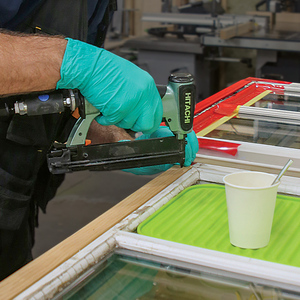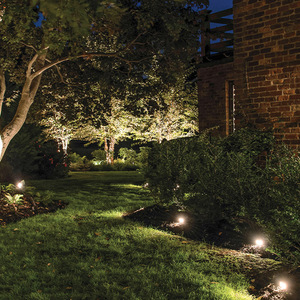What is the best way to construct a kitchen soffit? I have to run a 6″ duct line through it. Another 6 inch duct will intersect it at a 90 degree angle. And I would like to put recessed lights in it too. The room has 9 foot ceilings. I would like the upper cabinets to touch it and then have some room for crown. What size soffit would you recommend and what is the best way to build and firestop it? Thanks.



















Replies
I prefer to sheetrock the ceiling and walls, and then build the soffits. I find that way easier than installing a bunch of blocking for firestops, and dealing with any plumbing or wiring.
I've also started using 2x3 steel studs for building soffits. I think they're straighter; I know they're lighter; and they go up pretty quickly. I usually run a strip on the wall, and then build a "ladder" for the front. Make sure the ceiling is pretty level if you do it this way. If the ceiling is out of level, its easier to install a track on the ceiling, and work down from that.
If you don't get the soffit level, the cabinets and crown won't look good.
I like this idea of using the steel studs since 2x2's and 2x3's are usually warped, twisted and bowed. I have only worked with wood however. Are there any tips you would give to work with steel studs? guage? screws? cutting tools, methods?
Also, when the drywall guys come in are you there right behind them to put in the duct work, lighting and soffits, then they place and tape the soffits or do they come back?
For max space inside, I like to run a 2x2 along the ceiling line at the front face of the overcounter soffit, 24" out from the wall. A frame ladder is built as the frame for the bottom face of the soffit, with 2x2 longs and 2x3 flatwise rungs.
Do your rung layout in accordance with where you want bays for lighting.
A rip of 1/2" OSB is hung like a curtain from the ceiling cleat, its bottom edge is at the elevation of your rough soffit, and the ladder frame is boosted up and nailed to wall and OSB. Very important to get everything level, so your wallcabs with crown come up to a nice flat level plane of soffit.
Most often, it is easiest to hang all that ductwork up there before framing the soffit.
I use steel studs as well. 2x4's and track.
Sheetrock walls and ceilings first. Then laser your tracks on the walls and ceilings.
I cut all the way around them until I get to what will be the front 1-1/2". Bend them to a 90 degree angle. Repeat as many times as necessary.
Slide them into the tracks and screw into place.
Woods favorite carpenter
I'm not sure what you mean by "track" is that the piece of 2x4 that I secure to the ceiling and the wall?
I'm not sure what you are describing here either. "I cut all the way around them until I get to what will be the front 1-1/2". Bend them to a 90 degree angle. Repeat as many times as necessary." Is this how you form the "ladder" part?
Steel 2x4's and matching steel track. The track is the bottom and top plate in a steel framed wall.
I leave one of the 1-1/2" faces uncut and bend them to a 90 degree angle. So it's one piece, after I put a couple zip screws in it. Woods favorite carpenter
drywalling first is about the best way to fireblock, but it's problematic as far as the scheduling as the drywall guys have to come back to do a little bit of work. I'd say, in your case, since you want can lights too, it's doubly problematic, as that would have the electricians coming back for an extra trip too - read "trip charge!". Same goes for whoever is installing the ducts. If you are DIYing this stuff I guess it doesn't matter.
Another way to fireblock is, say you want a 12" high soffit, after your regular framing, you nail up 3/4" x 12" strips of plywood or OSB onto the wall and pushed up tight to the ceiling. Then you frame up the 12" tall soffits, and have your HVAC, electrician, and then drywall guy come and do the house as normal. Runs much smoother that way.
RE the size, they may be around 10 or 12" high. The width depends on what you are doing with the can lights. All in all, you are going to have to figure it out yourself.
Edited 1/22/2008 7:17 pm ET by Matt
how big of a soffit do you build.two ways to screw up concrete 1) concrete driver 2) concrete finisher
depends.
Upper cabinets vary in depth, most are 12", some are 15", and the one that gets everybody including the electrician and his can lights are the 24" deep cabinets. Usually over the frig.
So depending on his cabinets+crown+1-2" for a reveal and 8-10" for lights, is how deep his soffitt needs to be.
Woods favorite carpenter
Edited 1/22/2008 8:25 pm ET by MattSwanger
look at the pipe coming out of the wall. that is a vent pipe around the window for the kitcrn sink. could not contain it in the wall because a gable truss is setting on top of that wall.So do I soffit it or fake wall in caninet..two ways to screw up concrete 1) concrete driver 2) concrete finisher
8' ceilings?
If so, then if you don't soffitt it then you will be able to see it. Cabinets won't go all the way to the ceiling.
A soffitt is alot of work for that little pipe, maybe build a small box around it that sits on top of the cabinets, painted the wall color. Or even matching the cupboard finish.
I am doing that on a kitchen I have going right now, have to cover up the microwave vent pipe. So I built a cherry box for it to match the cabinets.
Whats the PVC pipe sticking through the middle of the ceiling? Woods favorite carpenter
Harvester
Here's a pic showing metal track and studs I did in a commercial job hope it helps
Zeeya
View Image
View Image
I've used plywood as a soffit material also. (1/2") It has some structural ability on it's own. Easier to use than cutting a bunch of pieces of individual lumber - or steel. Fasten one hanger behind it at the top, another one at the bottom, maybe one against the wall. Go to town.
Don K.
EJG Homes Renovations - New Construction - Rentals
2 x 12 lumber . Install before rock , makes the firestop and frame in one shot. Cut a few pieces for cross blocking for stiffeners and where the deep soffit over the fridge is.
Use H 2.5 ties off of joists to hang the front from.
I've done standard 2X, ply strips, and metal. The last two are my favorites. In the old days (the 70s), mid-grade remodels in old houses often went like this: 1) Set the bases. 2) Set the counters, complete with full 18" backsplash, covering up all old plaster, elec. runs, etc. 3) Set the uppers, using the full backsplash as a ledger. 4) Climb up onto your bench with a pair of snips and a drill, and frame a metal soffit up from the top of the cabinets. If you had a helper, there was no need to climb down until the first coat of mud was on. Very efficient.
Back then, you were your own countertop guy, though. These days, laminate is history, and we've been forced out of Corian installation by prohibitively expensive certification classes where we spend all of our time getting the instructor up to speed. And Corian is passé, anyway: everyone is doing granite! So we still do bases first anyway, just to get the countertop guys in quickly.
Doing metal-framed soffits last still makes sense: the firestopping is done because the walls and ceilings are already drywalled. There's not really all that much drywall work left for you to do, so it can work out well economically,too. And the soffits will line up perfectly with your dead-level uppers, ensuring consistent crown reveals, which are hard to get when following twisted 2X framing.